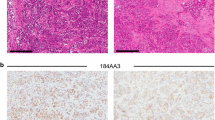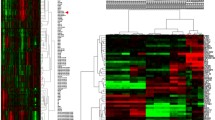Abstract
Breast cancer remains one of the most common malignant diseases in women in North America and Western Europe, yet therapies for the more aggressive estrogen independent tumors are limited and few model systems are available for the study of this type of breast cancer. In these studies, we characterized a novel estrogen independent breast cancer cell line, SUM-159PT. SUM-159PT cells are epithelial in origin, demonstrated by expression of cytokeratin 18. SUM-159PT cells are estrogen independent, demonstrated by lack of estrogen receptor (ER) protein and ER ligand binding studies. Furthermore, SUM-159PT cells injected subcutaneously or orthotopically are tumorigenic in ovariectomized athymic nude mice in the absence of estradiol supplementation. SUM-159PT cells are capable of invading through an 8 μm Matrigel membrane and display a stellate morphology in Matrigel, indicative of a metastatic phenotype. Correlating with this phenotype, we have detected secondary tumors upon inoculation of SUM-159PT cells into the mammary fat pad. To further investigate the metastatic potential of the SUM-159PT cells, we examined the expression of two proteins, vimentin and E-cadherin, implicated in the transition of carcinoma cells to a metastatic phenotype. Western blot and immunohistochemical analysis demonstrated that both SUM-159PT cells and xenografts express vimentin. No expression of E-cadherin was detected in SUM-159PT cells. Our data indicate that despite estrogen independence, SUM-159PT cells are growth inhibited in vitro by compounds such as 1,25(OH)2D3, transforming growth factor β (TGF-β), and the phorbol ester TPA. These studies indicate that SUM-159PT cells represent a good model system for the study of late stage estrogen independent, invasive breast cancer.
Similar content being viewed by others
References
Association AC, Cancer Facts and Figures-1997, American Cancer Society, Inc.: Atlanta.
Liotta LA: Cancer cell invasion and metastasis. Scientific American 226: 54–63, 1992
Chambers AF, Matrisian LM: Changing views of the role of matrix metalloproteinases in metastasis. J Natl Cancer Inst 89(17): 1260–1270, 1997
Fidler IJ: Critical factors in the biology of human cancer metastasis. Twenty-eighth G.H.A. Clowes memorial award lecture. Cancer Res 50(19): 6130–6138, 1990
Seshadri R, Raymond WA, Leong AS, Horsfall DJ, McCaul K: Vimentin expression is not associated with poor prognosis in breast cancer. Int J Cancer 67(3): 353–356, 1996
Thompson EW, Paik S, Brunner N, Sommers CL, Zugmaier G, Clarke R, Shima TB, Toni J, Donahue S, Lippman ME: Association of increased basement membrane invasiveness with absence of estrogen receptor and expression of vimentin in human breast cancer cell lines. J Cell Physiol 150(3): 534–544, 1992
Cattoretti G, Andreola S, Clemente C, D'Amato L, Rilke F: Vimentin and p53 expression on epidermal growth factor receptor-positive, oestrogen receptor-negative breast carcinomas. Br J Cancer 57: 353–357, 1988
Hendrix MJ, Seftor FA, Seftor RE, Trevor KT: Experimental co-expression of vimentin and keratin intermediate filaments in human breast cancer cells results in phenotypic interconversion and increased invasive behavior. Am J Pathol 150(2): 483–495, 1997
Sommers CL, Byers SW, Thompson EW, Torri JA, Gelmann EP: Differentiation state and invasiveness of human breast cancer cell lines. Breast Cancer Res Treat 31(2- 3): 325–335, 1994
Siitonen SM, Kononen JT, Helin HJ, Rantala IS, Holli KA, Isola JJ: Reduced E-cadherin expression is associated with invasiveness and unfavorable prognosis in breast cancer. Am J Clin Pathol 105(4): 394–402, 1996
Behrens J, Mareel MM, Van Roy FM, Birchmeier W: Dissecting tumor cell invasion: epithelial cells acquire invasive properties after the loss of uvomorulin mediated cell- cell adhesion. J Cell Biol 108(6): 2435–2447, 1989
Sommers CL, Thompson EW, Torri JA, Kemler R, Gelmann EP, Byers SW: Cell adhesion molecule uvomorulin expression in human breast cancer cell lines: relationship to morphology and invasive capacities. Cell Growth Differ 2(8): 365–372, 1991
Ignatoski KMW, Ethier SP: Constitutive activation of pp125f ak in eleven newly isolated human breast cancer cell lines. Breast Cancer Res Treat 54: 173–182, 1999
Forozan F, Veldman R, Ammerman CA, Parsa NZ, Kallioniemi A, Kallioniemi O, Ethier SP: Phenotypic and genetic characterization of 11 new breast cancer cell lines. Brit J Cancer (In press)
Ethier SP, Mahacek ML, Gullick WJ, Frank TS, Weber BL: Differential isolation of normal luminal mammary epithelial cells and breast cancer cells from primary and metastatic sites using selective media Cancer Res 53: 627–635, 1993
Sommers CL, Walker-Jones D, Heckford SE, Worland P, Valverius E, Clark R, McCormick F, Stampfer M, Abularach S, Gelmann EP: Vimentin rather than keratin expression in some hormone-independent breast cancer cell lines and in oncogene-transformed mammary epithelial cells. Cancer Res 49: 4258–4263, 1989
Athanassiadou P, Athanassiades P, Kyrkou K, Giahnaki E, Giannioti E, Nanas S: Expression of vimentin and epidermal growth factor receptor in effusions from patients with breast cancer; correlation with oestrogen and progesterone receptor status. Cytopathology 4(2): 91–98, 1993
Stover DM, Carey I, Garzon RJ, Zehner ZE: A negative regulatory factor is missing in a human metastatic breast cancer cell line. Cancer Res 54(12): 3092–3095, 1994
Kramer RH, Bensch KG, Wong J: Invasion of reconstituted basement membrane matrix by metastatic human tumor cells. Cancer Res 46: 1980–1986, 1986
Price JE, Polyzos A, Zhang RD, Daniels LM: Tumorigenicity and metastasis of human breast carcinoma cell lines in nude mice. Cancer Res 50(3): 717–721, 1990
Bao L, Matsumura Y, Baban D, Sun Y, Tarin D: Effects of inoculation site andMatrigel on growth and metastasis of human breast cancer cells. Br J Cancer 70(2): 228–232, 1994
Miller FR: Comparison of metastasis of mammary tumors growing in the mammary fatpad versus the subcutis. Invasion Metastasis 1(4): 220–226, 1981
Price JE: Metastasis from human breast cancer cell lines. Breast Cancer Res Treat 39(1): 93–102, 1996
Buras RR, Schumaker LM, Davoodi F, Brenner RV, Shabahang M, Nauta RJ, Evans SR: Vitamin D receptors in breast cancer cells. Breast Cancer Res Treat 31(2- 3): 191–202, 1994
Simboli-Campbell M, Narvaez CJ, Tenniswood M, Welsh J: 1,25-Dihydroxyvitamin D3 induces morphological and biochemical markers of apoptosis in MCF-7 breast cancer cells. J Steroid Biochem Mol Biol 58(4): 367–376, 1996
Simboli-Campbell M, Narvaez CJ, van Weelden K, Tenniswood M, Welsh J: Comparative effects of 1,25(OH)2D3 and EB1089 on cell cycle kinetics and apoptosis in MCF-7 breast cancer cells. Breast Cancer Res Treat 42(1): 31–41, 1997
Clarke R, Skaar T, Baumann K, Leonessa F, James M, Lippman J, Thompson EW, Freter C, Brunner N: Hormonal carcinogenesis in breast cancer: cellular and molecular studies of malignant progression. Breast Cancer Res Treat 31(2- 3): 237–248, 1994
Brunner N, Frandsen TL, Holst-Hansen C, Bei M, Thompson EW, Wakeling AE, Lippman ME, Clarke R: MCF7/LCC2: a 4-hydroxytamoxifen resistant human breast cancer variant that retains sensitivity to the steroidal antiestrogen ICI 182,780. Cancer Res 53(14): 3229–3232, 1993
Byers S, Pishvaian M, Crockett C, Peer C, Tozeren A, Sporn M, Anzano M, Lechleider R: Retinoids increase cell- cell adhesion strength, beta-catenin protein stability, and localization to the cell membrane in a breast cancer cell line: a role for serine kinase activity. Endocrinology 137(8): 3265–3273, 1996
Bracke ME, Charlier C, Bruyneel EA, Labit C, Mareel MM, Castronovo V: Tamoxifen restores the E-cadherin function in human breast cancer MCF-7/6 cells and suppresses their invasive phenotype. Cancer Res 54(17): 4607–4609, 1994
Vleminckx K, Vakaet L, Mareel M, Fiers W, van Roy F: Genetic manipulation of E-cadherin expression by epithelial tumor cell reveals an invasion suppressor role. Cell 66: 107–119, 1991
Arteaga CL, Tandon AK, Von Hoff DD, Osborne CK: Transforming growth factor beta: potential autocrine growth inhibitor of estrogen receptor-negative human breast cancer cells. Cancer Res 48(14): 3898–3904, 1988
Welsh J: Induction of apoptosis in breast cancer cells in response to vitamin D and antiestrogens. Biochem Cell Biol 72: 537–545, 1994
James SY, Mackay AG, Colston K: Effects of 1,25 dihydroxyvitamin D3 and its analogues on induction of apoptosis in breast cancer cells. J Steroid Biochem Mol Biol 58: 395–401, 1996
Berger U, McClelland R, Wilson P, Green G, Haussler M, Pike P, Colston K, Easton D, Coombes RC: Immunocytochemical determination of estrogen receptor, progesterone receptor and 1,25-(OH)2-vitamin D3 receptor in breast cancer and relationship to prognosis. Cancer Res 51: 239–244, 1991
Rights and permissions
About this article
Cite this article
Flanagan, L., Weelden, K.V., Ammerman, C. et al. SUM-159PT cells: a novel estrogen independent human breast cancer model system. Breast Cancer Res Treat 58, 193–204 (1999). https://doi.org/10.1023/A:1006331716981
Issue Date:
DOI: https://doi.org/10.1023/A:1006331716981




